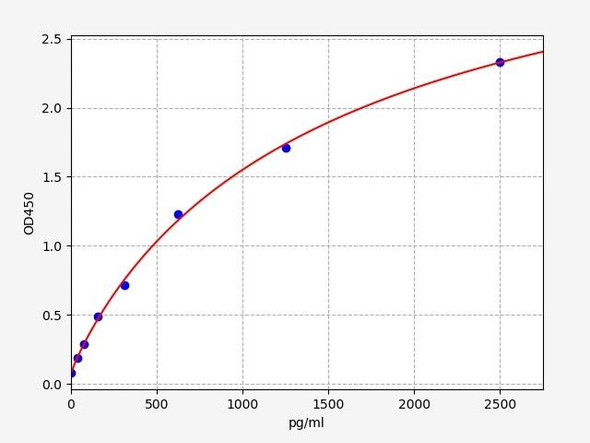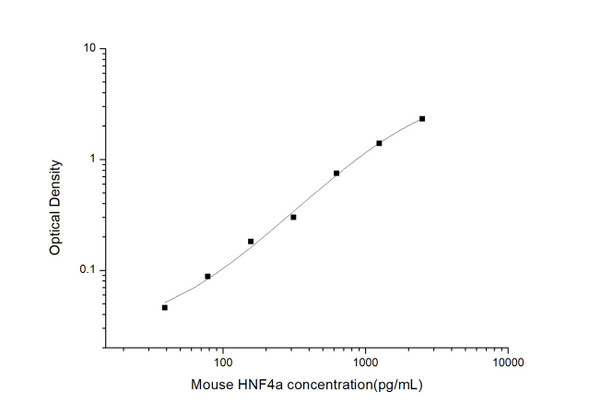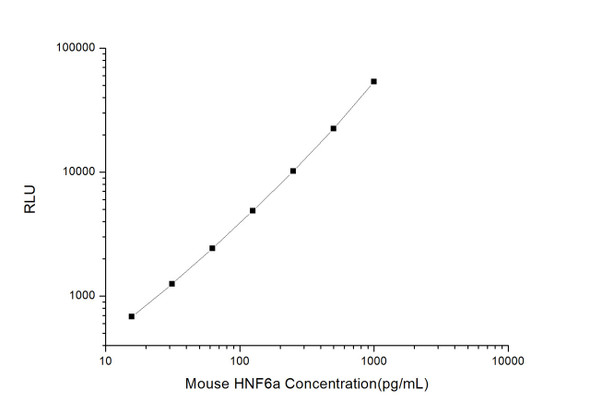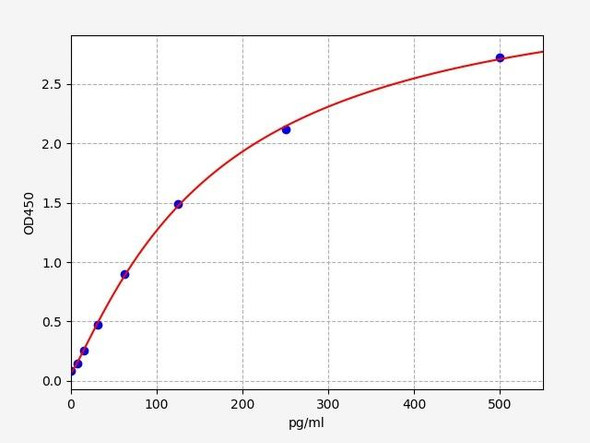Mouse Cell Biology ELISA Kits 2
Mouse HNF4a (Hepatocyte Nuclear Factor 4 Alpha) CLIA Kit (MOES00361)
- SKU:
- MOES00361
- Product Type:
- ELISA Kit
- ELISA Type:
- CLIA Kit
- Size:
- 96 Assays
- Sensitivity:
- 9.38pg/mL
- Range:
- 15.63-1000pg/mL
- ELISA Type:
- Sandwich
- Reactivity:
- Mouse
- Sample Type:
- Serum, plasma and other biological fluids
- Research Area:
- Cell Biology
Description
| Assay type: | Sandwich |
| Format: | 96T |
| Assay time: | 4.5h |
| Reactivity: | Mouse |
| Detection method: | Chemiluminescence |
| Detection range: | 15.63-1000 pg/mL |
| Sensitivity: | 9.38 pg/mL |
| Sample volume: | 100µL |
| Sample type: | Serum, plasma and other biological fluids |
| Repeatability: | CV < 15% |
| Specificity: | This kit recognizes Mouse HNF4a in samples. No significant cross-reactivity or interference between Mouse HNF4a and analogues was observed. |
This kit uses Sandwich-CLIA as the method. The micro CLIA plate provided in this kit has been pre-coated with an antibody specific to Mouse HNF4a. Standards or samples are added to the appropriate micro CLIA plate wells and combined with the specific antibody. Then a biotinylated detection antibody specific for Mouse HNF4a and Avidin-Horseradish Peroxidase (HRP) conjugate are added to each micro plate well successively and incubated. Free components are washed away. The substrate solution is added to each well. Only those wells that contain Mouse HNF4a, biotinylated detection antibody and Avidin-HRP conjugate will appear fluorescence. The Relative light unit (RLU) value is measured spectrophotometrically by the Chemiluminescence immunoassay analyzer. The RLU value is positively associated with the concentration of Mouse HNF4a. The concentration of Mouse HNF4a in the samples can be calculated by comparing the RLU of the samples to the standard curve.
| UniProt Protein Function: | HNF4 alpha: a nuclear transcription factor which binds DNA as a homodimer. Controls the expression of several genes, including hepatocyte nuclear factor 1 alpha, a transcription factor which regulates the expression of several hepatic gene, alpha 1-antitrypsin, apolipoprotein CIII, and transthyretin genes. May be essential for development of the liver, kidney and intestine. Mutations have been associated with monogenic autosomal dominant non-insulin-dependent diabetes mellitus type I. Four alternatively spliced isoforms have been described. |
| UniProt Protein Details: | Protein type:DNA-binding; Nuclear receptor; Transcription factor Chromosomal Location of Human Ortholog: 2 H3|2 84. 32 cM Cellular Component: cytoplasm; nucleoplasm; nucleus; transcription factor complex Molecular Function:acyl-CoA binding; DNA binding; fatty acid binding; palmitoyl-CoA hydrolase activity; protein binding; protein homodimerization activity; receptor binding; RNA polymerase II transcription factor activity, enhancer binding; sequence-specific DNA binding; transcription factor activity; transcription factor binding Biological Process: acyl-CoA metabolic process; blood coagulation; cell differentiation; establishment of tissue polarity; glucose homeostasis; intercellular junction assembly and maintenance; lipid homeostasis; lipid metabolic process; negative regulation of cell growth; negative regulation of cell proliferation; negative regulation of mitotic cell cycle; negative regulation of protein import into nucleus, translocation; negative regulation of transcription factor activity; negative regulation of tyrosine phosphorylation of STAT protein; ornithine metabolic process; phospholipid homeostasis; positive regulation of fatty acid biosynthetic process; positive regulation of gluconeogenesis; positive regulation of transcription from RNA polymerase II promoter; positive regulation of transcription, DNA-dependent; regulation of gastrulation; regulation of insulin secretion; regulation of lipid metabolic process; regulation of microvillus biogenesis; regulation of transcription from RNA polymerase II promoter; regulation of transcription, DNA-dependent; response to glucose stimulus; sex differentiation; xenobiotic metabolic process |
| NCBI Summary: | The protein encoded by this gene is a transcription factor involved in the development of the pancreas, liver, kidney, and intestines. The encoded protein also functions to maintain glucose homeostasis. Several transcript variants encoding different isoforms have been found for this gene. [provided by RefSeq, Aug 2015] |
| UniProt Code: | P49698 |
| NCBI GenInfo Identifier: | 148886625 |
| NCBI Gene ID: | 15378 |
| NCBI Accession: | P49698. 2 |
| UniProt Secondary Accession: | P49698,Q3UNX3, Q8CFY1, A2A5I5, A2ICH0, |
| UniProt Related Accession: | P49698 |
| Molecular Weight: | 53 kDa |
| NCBI Full Name: | Hepatocyte nuclear factor 4-alpha |
| NCBI Synonym Full Names: | hepatic nuclear factor 4, alpha |
| NCBI Official Symbol: | Hnf4a |
| NCBI Official Synonym Symbols: | Hnf4; HNF-4; MODY1; Nr2a1; Tcf14; TCF-14; Hnf4alpha |
| NCBI Protein Information: | hepatocyte nuclear factor 4-alpha |
| UniProt Protein Name: | Hepatocyte nuclear factor 4-alpha |
| UniProt Synonym Protein Names: | Nuclear receptor subfamily 2 group A member 1; Transcription factor 14; TCF-14; Transcription factor HNF-4 |
| Protein Family: | Hepatocyte nuclear factor |
| UniProt Gene Name: | Hnf4a |
As the RLU values of the standard curve may vary according to the conditions of the actual assay performance (e. g. operator, pipetting technique, washing technique or temperature effects), the operator should establish a standard curve for each test. Typical standard curve and data is provided below for reference only.
| Concentration (pg/mL) | RLU | Average | Corrected |
| 1000 | 52128 55222 | 53675 | 53650 |
| 500 | 21436 23542 | 22489 | 22464 |
| 250 | 10663 9759 | 10211 | 10186 |
| 125 | 4684 5118 | 4901 | 4876 |
| 62.5 | 2636 2270 | 2453 | 2428 |
| 31.25 | 1311 1251 | 1281 | 1256 |
| 15.63 | 696 720 | 708 | 683 |
| 0 | 24 26 | 25 | -- |
Precision
Intra-assay Precision (Precision within an assay): 3 samples with low, mid range and high level Mouse HNF4a were tested 20 times on one plate, respectively.
Inter-assay Precision (Precision between assays): 3 samples with low, mid range and high level Mouse HNF4a were tested on 3 different plates, 20 replicates in each plate.
| Intra-assay Precision | Inter-assay Precision | |||||
| Sample | 1 | 2 | 3 | 1 | 2 | 3 |
| n | 20 | 20 | 20 | 20 | 20 | 20 |
| Mean (pg/mL) | 49.01 | 137.97 | 417.26 | 51.55 | 129.23 | 442.70 |
| Standard deviation | 5.42 | 16.35 | 33.09 | 6.40 | 14.63 | 48.12 |
| C V (%) | 11.06 | 11.85 | 7.93 | 12.42 | 11.32 | 10.87 |
Recovery
The recovery of Mouse HNF4a spiked at three different levels in samples throughout the range of the assay was evaluated in various matrices.
| Sample Type | Range (%) | Average Recovery (%) |
| Serum (n=5) | 95-111 | 102 |
| EDTA plasma (n=5) | 97-110 | 105 |
| Cell culture media (n=5) | 100-112 | 106 |
Linearity
Samples were spiked with high concentrations of Mouse HNF4a and diluted with Reference Standard & Sample Diluent to produce samples with values within the range of the assay.
| Serum (n=5) | EDTA plasma (n=5) | Cell culture media (n=5) | ||
| 1:2 | Range (%) | 93-106 | 94-110 | 103-118 |
| Average (%) | 100 | 101 | 109 | |
| 1:4 | Range (%) | 96-112 | 95-110 | 93-107 |
| Average (%) | 104 | 102 | 101 | |
| 1:8 | Range (%) | 85-97 | 94-109 | 96-113 |
| Average (%) | 92 | 100 | 104 | |
| 1:16 | Range (%) | 95-107 | 93-106 | 92-108 |
| Average (%) | 101 | 99 | 100 |
An unopened kit can be stored at 4°C for 1 month. If the kit is not used within 1 month, store the items separately according to the following conditions once the kit is received.
| Item | Specifications | Storage |
| Micro CLIA Plate(Dismountable) | 8 wells ×12 strips | -20°C, 6 months |
| Reference Standard | 2 vials | |
| Concentrated Biotinylated Detection Ab (100×) | 1 vial, 120 µL | |
| Concentrated HRP Conjugate (100×) | 1 vial, 120 µL | -20°C(shading light), 6 months |
| Reference Standard & Sample Diluent | 1 vial, 20 mL | 4°C, 6 months |
| Biotinylated Detection Ab Diluent | 1 vial, 14 mL | |
| HRP Conjugate Diluent | 1 vial, 14 mL | |
| Concentrated Wash Buffer (25×) | 1 vial, 30 mL | |
| Substrate Reagent A | 1 vial, 5 mL | 4°C (shading light) |
| Substrate Reagent B | 1 vial, 5 mL | 4°C (shading light) |
| Plate Sealer | 5 pieces | |
| Product Description | 1 copy | |
| Certificate of Analysis | 1 copy |
- Set standard, test sample and control (zero) wells on the pre-coated plate and record theirpositions. It is recommended to measure each standard and sample in duplicate. Note: addall solutions to the bottom of the plate wells while avoiding contact with the well walls. Ensuresolutions do not foam when adding to the wells.
- Aliquot 100µl of standard solutions into the standard wells.
- Add 100µl of Sample / Standard dilution buffer into the control (zero) well.
- Add 100µl of properly diluted sample (serum, plasma, tissue homogenates and otherbiological fluids. ) into test sample wells.
- Cover the plate with the sealer provided in the kit and incubate for 90 min at 37°C.
- Aspirate the liquid from each well, do not wash. Immediately add 100µL of BiotinylatedDetection Ab working solution to each well. Cover the plate with a plate seal and gently mix. Incubate for 1 hour at 37°C.
- Aspirate or decant the solution from the plate and add 350µL of wash buffer to each welland incubate for 1-2 minutes at room temperature. Aspirate the solution from each well andclap the plate on absorbent filter paper to dry. Repeat this process 3 times. Note: a microplatewasher can be used in this step and other wash steps.
- Add 100µL of HRP Conjugate working solution to each well. Cover with a plate seal andincubate for 30 min at 37°C.
- Aspirate or decant the solution from each well. Repeat the wash process for five times asconducted in step 7.
- Add 100µL of Substrate mixture solution to each well. Cover with a new plate seal andincubate for no more than 5 min at 37°C. Protect the plate from light.
- Determine the RLU value of each well immediately.






